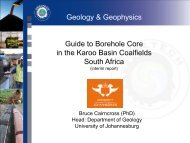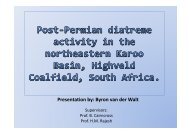coaltech upper olifants river catchment wetland inventory ...
coaltech upper olifants river catchment wetland inventory ...
coaltech upper olifants river catchment wetland inventory ...
You also want an ePaper? Increase the reach of your titles
YUMPU automatically turns print PDFs into web optimized ePapers that Google loves.
1. INTRODUCTION<br />
The Environmental Business Unit of Exigent Engineering Consultants was appointed by<br />
Coaltech 2020 to collate all available literature on the <strong>wetland</strong>s in the Upper Olifants<br />
River Catchment (UORC) and to compile a <strong>wetland</strong> map for the area with an associated<br />
<strong>wetland</strong> database.<br />
The UORC as defined by the Department of Water Affairs and Forestry (DWAF) includes<br />
the Olifants River and all its tributaries up to the Loskop Dam (Figure 1). In the report<br />
compiled by Palmer et al (2002) on <strong>wetland</strong>s in the UORC, the Olifants River and its<br />
tributaries up to the confluence of the Olifants River and the Klein Olifants River were<br />
included (Figure 3). In this report the UORC boundary encompasses the larger area as<br />
defined by DWAF (referred to as “the site”). The site incorporates the area as defined by<br />
Palmer et al (2002), but extends further to the north and east. A portion of Gauteng, as<br />
well as Mpumalanga is included in the <strong>catchment</strong>.<br />
According to the National Water Act (No 36 of 1998) a <strong>wetland</strong> is defined as, “land which is<br />
transitional between terrestrial and aquatic systems where the water table is usually at or<br />
near the surface, or the land is periodically covered with shallow water, and which land in<br />
normal circumstances supports or would support vegetation typically adapted to life in<br />
saturated soil.” This definition includes all naturally occurring <strong>wetland</strong>s and pans, but<br />
excludes <strong>river</strong>s, lakes and artificial <strong>wetland</strong>s, except for the transition zone from the <strong>river</strong>/lake<br />
and the terrestrial ecosystem.<br />
The definition of <strong>wetland</strong>s as defined in the Convention on Wetlands of International<br />
Importance especially as Waterfowl Habitat (Ramsar Convention) has a broader concept.<br />
Article 1.1 of the Ramsar Convention includes the following definition (Cowan 1995): “areas<br />
of marsh, fen, peatland or water, whether natural or artificial, permanent or temporary, with<br />
water that is static or flowing, fresh, brackish or salt, including areas or marine water the<br />
depth of which at low tide does not exceed six metres”. Rivers, lakes and artificial <strong>wetland</strong>s,<br />
as well as tidal zones, are therefore included in this definition.<br />
Wetland Database for UORC - 12 -




